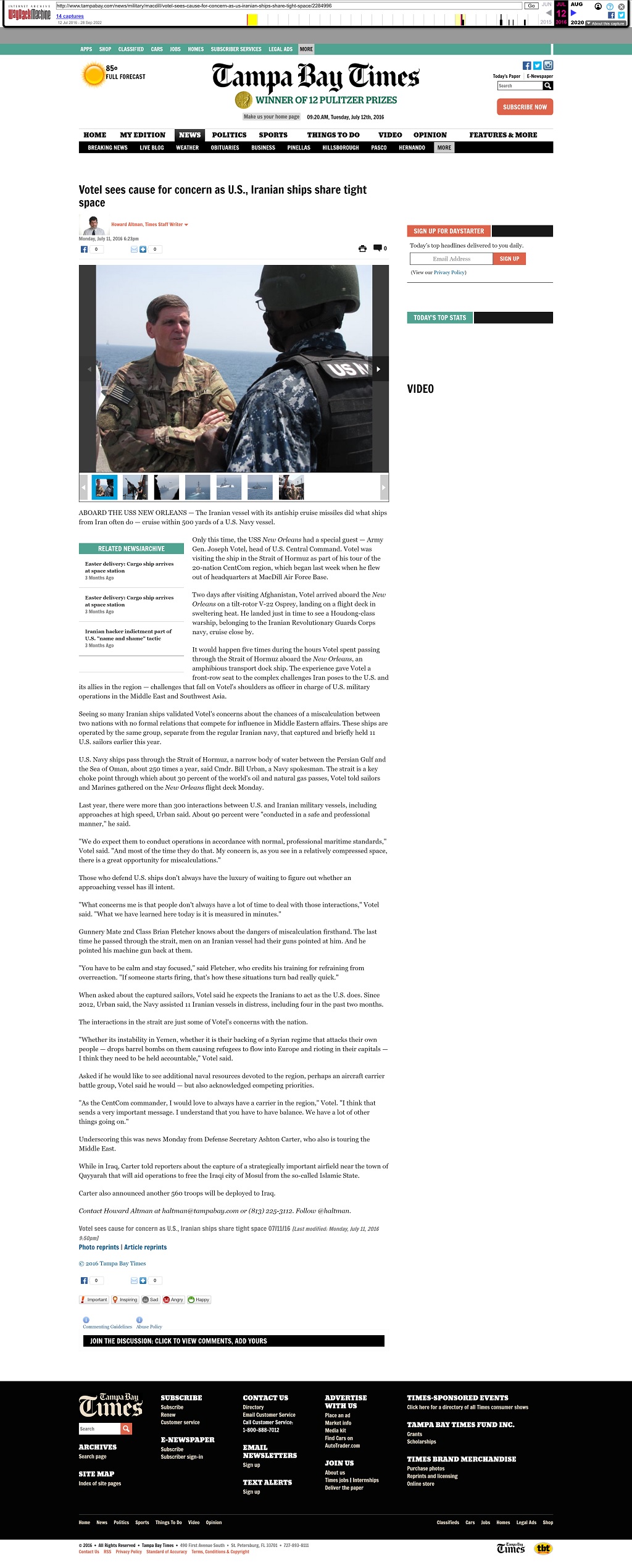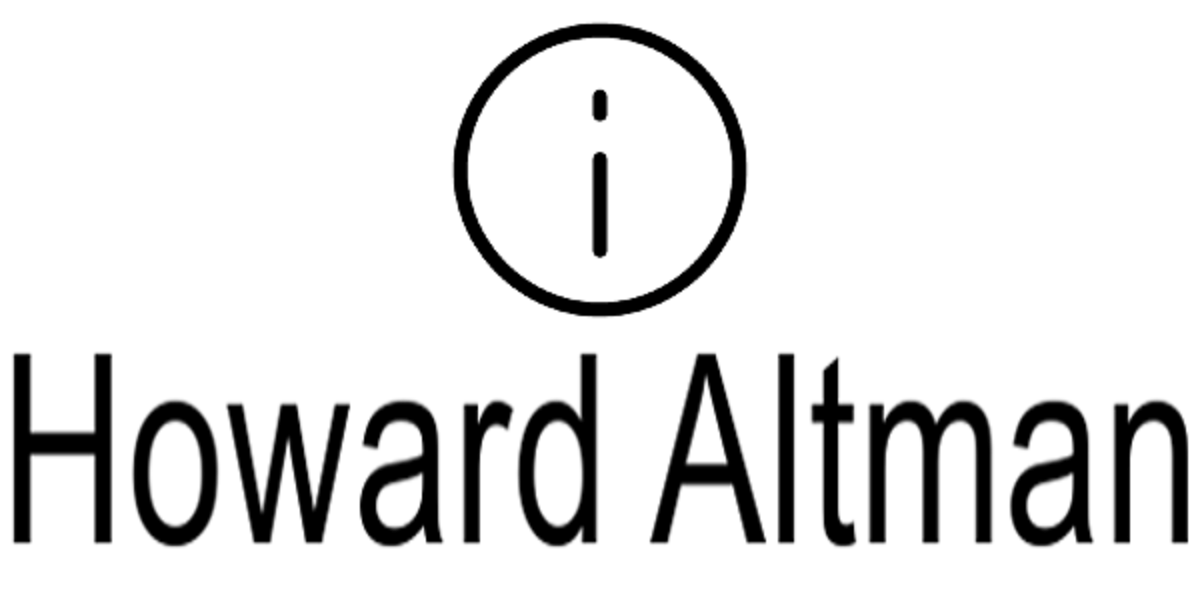
News / Military
By Howard Altman / Tampa Bay Times / July 11, 2016
PHOTO: Army Gen. Joseph Votel speaks with a Navy sailor during a visit to the USS New Orleans. Over Votel’s shoulder, approaching the American ship, is an Iranian war vessel. (Howard Altman | Times)
ABOARD THE USS NEW ORLEANS — The Iranian vessel with its antiship cruise missiles did what ships from Iran often do — cruise within 500 yards of a U.S. Navy vessel.
Only this time, the USS New Orleans had a special guest — Army Gen. Joseph Votel, head of U.S. Central Command. Votel was visiting the ship in the Strait of Hormuz as part of his tour of the 20-nation CentCom region, which began last week when he flew out of headquarters at MacDill Air Force Base.
Two days after visiting Afghanistan, Votel arrived aboard the New Orleans on a tilt-rotor V-22 Osprey, landing on a flight deck in sweltering heat. He landed just in time to see a Houdong-class warship, belonging to the Iranian Revolutionary Guards Corps navy, cruise close by.
It would happen five times during the hours Votel spent passing through the Strait of Hormuz aboard the New Orleans, an amphibious transport dock ship. The experience gave Votel a front-row seat to the complex challenges Iran poses to the U.S. and its allies in the region — challenges that fall on Votel’s shoulders as officer in charge of U.S. military operations in the Middle East and Southwest Asia.
Seeing so many Iranian ships validated Votel’s concerns about the chances of a miscalculation between two nations with no formal relations that compete for influence in Middle Eastern affairs. These ships are operated by the same group, separate from the regular Iranian navy, that captured and briefly held 11 U.S. sailors earlier this year.
U.S. Navy ships pass through the Strait of Hormuz, a narrow body of water between the Persian Gulf and the Sea of Oman, about 250 times a year, said Cmdr. Bill Urban, a Navy spokesman. The strait is a key choke point through which about 30 percent of the world’s oil and natural gas passes, Votel told sailors and Marines gathered on the New Orleans flight deck Monday.
Last year, there were more than 300 interactions between U.S. and Iranian military vessels, including approaches at high speed, Urban said. About 90 percent were “conducted in a safe and professional manner,” he said.
“We do expect them to conduct operations in accordance with normal, professional maritime standards,” Votel said. “And most of the time they do that. My concern is, as you see in a relatively compressed space, there is a great opportunity for miscalculations.”
Those who defend U.S. ships don’t always have the luxury of waiting to figure out whether an approaching vessel has ill intent.
“What concerns me is that people don’t always have a lot of time to deal with those interactions,” Votel said. “What we have learned here today is it is measured in minutes.”
Gunnery Mate 2nd Class Brian Fletcher knows about the dangers of miscalculation firsthand. The last time he passed through the strait, men on an Iranian vessel had their guns pointed at him. And he pointed his machine gun back at them.
“You have to be calm and stay focused,” said Fletcher, who credits his training for refraining from overreaction. “If someone starts firing, that’s how these situations turn bad really quick.”
When asked about the captured sailors, Votel said he expects the Iranians to act as the U.S. does. Since 2012, Urban said, the Navy assisted 11 Iranian vessels in distress, including four in the past two months.
The interactions in the strait are just some of Votel’s concerns with the nation.
“Whether its instability in Yemen, whether it is their backing of a Syrian regime that attacks their own people — drops barrel bombs on them causing refugees to flow into Europe and rioting in their capitals — I think they need to be held accountable,” Votel said.
Asked if he would like to see additional naval resources devoted to the region, perhaps an aircraft carrier battle group, Votel said he would — but also acknowledged competing priorities.
“As the CentCom commander, I would love to always have a carrier in the region,” Votel. “I think that sends a very important message. I understand that you have to have balance. We have a lot of other things going on.”
Underscoring this was news Monday from Defense Secretary Ashton Carter, who also is touring the Middle East.
While in Iraq, Carter told reporters about the capture of a strategically important airfield near the town of Qayyarah that will aid operations to free the Iraqi city of Mosul from the so-called Islamic State.
Carter also announced another 560 troops will be deployed to Iraq.
- Photo 2: Brian Fletcher, a gunner’s mate second class aboard the USS New Orleans, had Iranian guns pointed at him during an earlier passage through the Strait of Hormuz. The strait separates the Gulf of Oman and the Persian Gulf. [Howard Altman | Times]
- Photo 3: A tilt-rotor V-22 Osprey, which can operate as an airplane or helicopter, approaches the deck of the USS New Orleans on Monday in the Strait of Hormuz, off Iranian shores. [Howard Altman | Times]
- Photo 4: The USS Stout, a guided-missile destroyer, escorts the amphibious dock ship USS New Orleans through the Strait of Hormuz. Iran forms the northern border of the strait. [Howard Altman | Times]
- Photo 5, 6: Approaching within 500 yards of the USS New Orleans is an Houdong-class ship belonging to the Iranian Revolutionary Guards Corps Navy, an institution separate from the regular Iranian navy. [Howard Altman | Times]
- Photo 7: Army Gen. Joseph Votel, aboard the USS New Orleans, reviews the rigid-hull inflatable boats stowed aboard the amphibious transport dock ship. Votel, head of Tampa-based U.S. Central Command, visited the New Orleans as part of a tour of the 20-nation CentCom region. [Howard Altman | Times]
Wayback image

